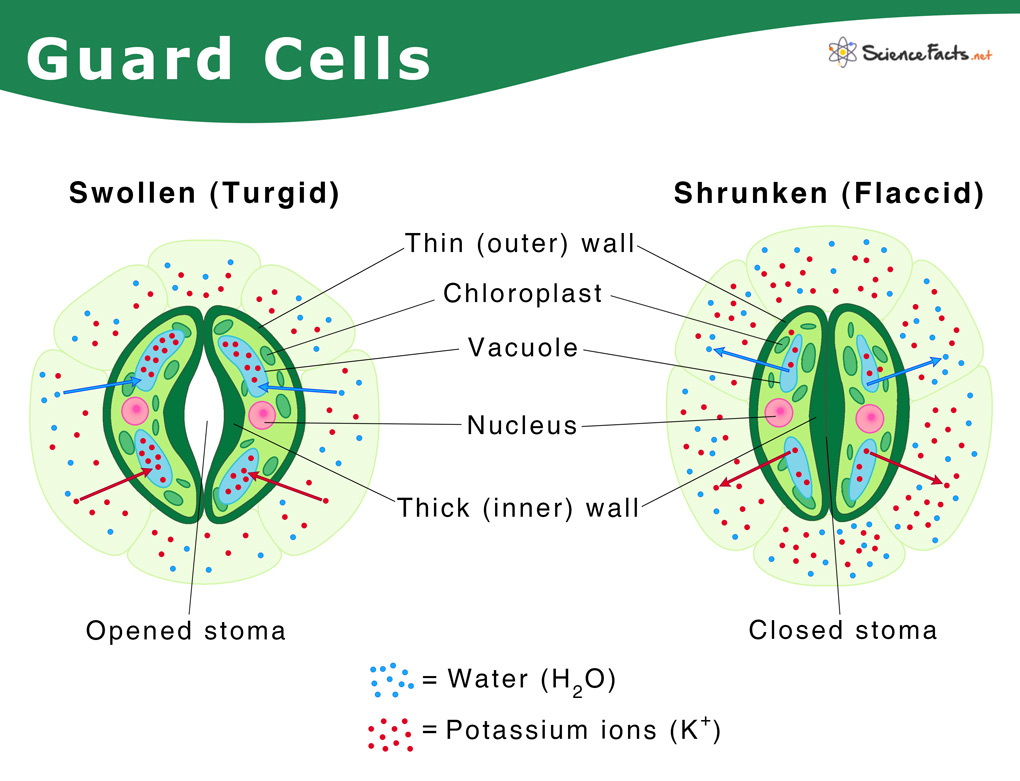Guard Cells
What are Guard Cells and Where are They Located
Guard cells are a pair of bean-shaped cells found in the epidermis of leaves and young stems of plants. They look similar to a kidney and exist in pairs surrounding a tiny gas exchange opening called a stoma. Guard cells help plants to perform photosynthesis, get rid of wastes, and excess water.
Structure
They are bean or kidney-shaped cells found on the epidermis of a plant. Between two guard cells is a pore called a stoma that regulates gas exchange in plants. Each guard cell has a thick cuticle on the pore-side and a thin-one on the opposite side.
Compared to the rest of the leaf, the cuticle of guard cells is more permeable to water vapor. Cuticle permeability also depends on its chemical composition. In young and developing guard cells, cellulose and pectin are deposited into the plasmodesmata, forming a thin cytoplasm layer. However, they disappear in a mature guard cell. The cellulose microfibrils are oriented radially in the cell walls.
Subsidiary cells, also known as accessory cells, are epidermal cells surrounding each guard cell. They help in the interaction between the guard cells and the other epidermal cells, protecting the latter from guard cell expansion.
Parts
Guard cells are found to contain different cell organelles based on the plant species. The typical cell organelles found in guard cells are:
- Mitochondria: The energy-producing organelle. Many mitochondria are found in the guard cells, proving that they have high metabolic activity.
- Lysosomes: Contain several digestive enzymes such as lipases, phosphates, and nucleases that help to break down large complex molecules and thus in the metabolism of guard cells.
- Ribosomes: Helps in protein synthesis. They either remain stuck to the endoplasmic reticulum or are free in the cytosol.
- Endoplasmic Reticulum (ER): They are of two different types. Rough endoplasmic reticulum (RER), when attached to ribosomes, and the smooth endoplasmic reticulum (SER) when they are devoid of them. Together with ribosomes, the rough endoplasmic reticulum helps in protein synthesis. ER also helps in the synthesis of vesicles and vacuoles inside the cell.
- Nuclei: Found centrally in the guard cells, they contain the genetic material. Nuclei are found to change shape with the opening and closing of stomata.
- Chloroplast: They are double-membrane bound organelles found to vary in number from one plant to another. They help the guard cells to perform photosynthesis and produce a large amount of starch at night.
- Microtubules: Provide flexibility and movement in guard cells. Microtubules also contribute to the building and development of guard cells.
- Lipid Droplets: They act as intermediates in the synthesis of wax and cutin.
What do Guard Cells Do
How do They Open and Close Stomata
Guard cells regulate the rate of transpiration in plants. Here, light works as a stimulator, based on which there are two possible situations:
In the Presence of Light
During this phase, water starts entering the guard cell, making them swell and becomes turgid. It is accompanied by two consecutive series of events, causing the stomata to open:
- Uptake of potassium ions (K+) by the guard cell from the surrounding. This K+ influx increases the solute potential but decreases the water potential inside the guard cell.
- Uptake of chloride ions (Cl–)
As the guard cell’s ion concentration rises, water starts to move inside the guard cell, making its thin side bulge outwards, similar to an inflated balloon. The thick side also moves in the same direction, making the guard cells look like the letter ‘O’. The pressure inside the guard cell is controlled by regulating ions and sugar molecules’ entry and exit.
In the Absence of Light
During this phase, loss of water from the guard cell through osmosis makes them flaccid and looks like the letter ‘I’. This influx of water occurs due to:
- Release of K+ ions from the guard cells to the neighboring cells
- Release of Cl– ions and malate from the guard cells
Other Functions
Transpiration: Opening of guard cells causes removal of excess water in the form of water vapor from the plant’s aerial parts, a process known as transpiration.
Gas Exchange: Facilitating the uptake of carbon dioxide and oxygen release through stomata during photosynthesis.
Keeping Moisture Balance: Controlling the opening and closing of stomata based on the environmental and internal factors, to maintain the desired moisture level within the cell.
-
References
Article was last reviewed on Friday, June 18, 2021




